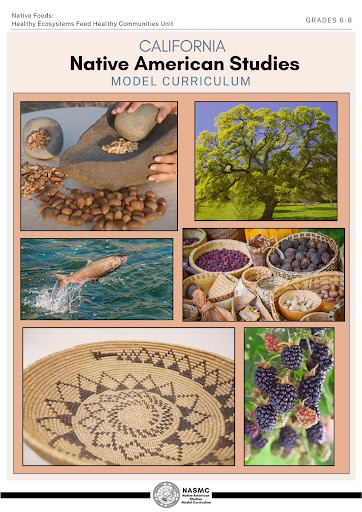Overview
Free Resources!
Traditional Ecological Knowledge Case Study: Fire

Author: This unit was researched, authored, and edited by the California Indian Museum and Cultural Center, California Indian Education for All, and the San Diego County Office of Education. Key writers and researchers of this unit are Nicole Lim, Jayden Lim, and Dr. Staci Block. The unit resources were designed and created from funding through the California Department of Education’s Native American Studies Model Curriculum grant and contract.
Grade(s): 6th-8th Grades
Suggested Amount of Time: Two 60 minute Class Periods
Curriculum Themes
- History
- Relationship to Place
Learning Goals
Understand the concept of Traditional Ecological Knowledge and its role in land stewardship.
Recognize the ecological benefits of controlled burning.
Analyze how fire impacts biodiversity, food webs, and cultural practices.
Reflect on the consequences of fire suppression and overgrowth.
Lesson Overview
This lesson explores the role of fire in maintaining healthy ecosystems through the lens of Traditional Ecological Knowledge (TEK). Students will examine the cultural, ecological, and practical significance of controlled burning as practiced by Native communities, apply these principles to scenarios, and analyze the impact of fire on biodiversity and food webs.
Teacher Background
In this lesson, students explore the role that fire plays in supporting healthy ecosystems. Students are introduced to an Indigenous approach to caring for the environment and apply these approaches to realistic scenarios.
Native peoples have cared for the environment using methodologies now referred to as Traditional Ecological Knowledge, or TEK, since time immemorial. During this time, Natives designed complex, specific strategies for protecting ecosystems, and with those ecosystems, community food webs.
Traditional Ecological Knowledge (TEK) differs from modern Western approaches to land management in that it encompasses all aspects of culture, health, and community life. Culturally significant plants and animal habitats are tended to with care; manipulation of plant species is performed in order to promote diversity and heighten production in order to meet a wide variety of cultural and nutritional needs. Common methods of caring for culturally significant plants include controlled burning, pruning, coppicing, transplanting, weeding, irrigation, and more. All of these strategies combined produced what many refer to as a “well-tended garden” throughout the land now known as California. Tending to the environment was a constant process, that ensured a steady availability of traditional foods and materials used in daily life.
When colonists and settler communities moved into California, they changed the way that humans interacted with the natural environment. Settlers, including modern conservationists, characterized Native people as lazy, unable to care for the vast “wilderness” in which they lived, and in desperate need of intervention. What settlers did not understand is that the land they were invading had been intentionally changed and cared for in order to support biodiversity, and to reduce the likelihood of natural disasters and ecosystem collapse. California Natives had been successful in securing reliable food sources and creating a natural environment in which abundance was the norm.
Once settlers took hold of California, Native populations were forced from their traditional homelands, moved into missions or boarding schools, sold into slave labor, or murdered. Native communities faced enormous physical and legal challenges when it came to tending the ecosystem and food webs, and settler governments designed new ways to manage the land. Cities and neighborhoods sprung up in the middle of floodplains, forests, and traditional fire paths. Forests and woodlands were cut down for lumber, making room for massive farms and vineyards. Cattle was introduced, as were new grasses preferred by cows. Instead of using fire to support food growth, settler governments tried to suppress fire whenever possible. California now faces a twelve-month fire season with wildfires ever increasing in size-a challenge that has been partially caused by settler dismissal of Traditional Ecological Knowledge. Today, many tribal communities are revitalizing traditional ecological practices in an attempt to protect the environment from the effects of climate change, restore food webs, and nurture traditional cultural practices.
For Native communities in California, the regular practice of controlled cultural burning is essential to nurturing the resources that are required for sustaining life and cultural traditions. Because cultural burning is a practice that is inseparable from Native culture and is a practice that may vary between tribal communities, it is something that must be taught on the land, by trusted tribal leaders. However, many settler communities, including people in power, are beginning to explore the concept of “Good Fire,” namely, that fire can be harnessed as a way to support the ecosystem and promote food growth. This concept, as you will explore with students in the following lessons, has been understood for thousands of years, and has been proven time and time again to work.
The use of cultural burning to support habitats happened seasonally and varied in frequency depending on the purpose. Because of the frequent, time specific use of fire, fires rarely grew out of control. While many Californians today associate fire with destruction and fear, it is estimated that the number of acres burned in California annually ranged from 5.6 million to 13 million acres. Most of these acres were burned intentionally for a wide variety of purposes. While different tribes burned for different reasons depending on their local ecosystem, below are some of the common uses of burning for the Pomo people in Northwestern California. This is just a sampling of uses, as there are countless applications of fire in California by Native peoples!